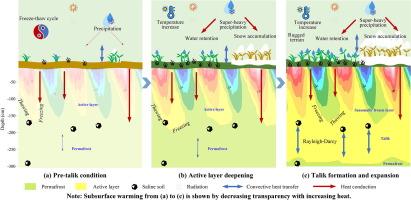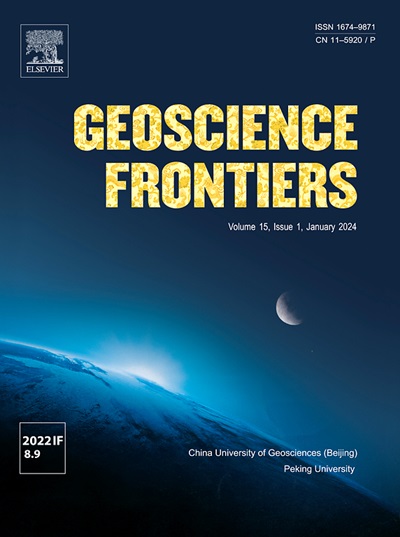Observed talik development triggers a tipping point in marginal permafrost of the Qinghai-Xizang Plateau
IF 8.9
1区 地球科学
Q1 GEOSCIENCES, MULTIDISCIPLINARY
引用次数: 0
Abstract
Permafrost, a critical component of Earth’s climate system, is increasingly subject to abrupt thaw events, which jeopardize infrastructure, reshape landforms, alter hydrological regimes, and disrupt ecosystems, thereby posing substantial threats to global sustainability. However, the underlying mechanisms that trigger these abrupt transitions remain incompletely understood. Here, we present decade-long in-situ observations from HRQ1, a marginal permafrost site in the Headwater Area of the Yellow River, northeastern Qinghai-Xizang Plateau. These data reveal the formation and growth of a talik, indicative of a permafrost tipping point. Absent before 2017, the talik subsequently formed and progressively deepened, extending to the maximum observation depth of 300 cm by 2024. The transition from perennially frozen to thawed conditions was accompanied by a substantial increase in mean annual soil temperature (MAST) throughout the entire soil profile. From 2015 to 2023, MAST in the upper 200 cm rose from sub-zero (−0.30 to −0.49 °C) to consistently above 0 °C (0.07 to 1.08 °C). Concurrently, maximum daily soil temperatures in deeper layers (200–300 cm) became positive, indicating thaw propagation into the relict permafrost. This warming coincided with a marked increase in unfrozen soil moisture, particularly within the expanding talik. The rapid, non-linear deepening of the talik, far exceeding rates attributable to conductive heat transfer alone, was driven by a strong convective mechanism (Rayleigh-Darcy instability). This advective process was triggered when the soil profile became fully saturated, a condition resulting from the convergence of intensified rainfall and enhanced water retention linked to decadal vegetation greening. Intriguingly, despite the accelerated subsurface warming, the annual amplitude of ground surface temperature decreased from 29.0 ± 2.8 °C to 24.5 ± 3.6 °C following talik formation, likely due to the buffering effect of increased vegetation cover, which modified the surface energy balance. Our results demonstrate that climatic warming and wetting can initiate a cascade of internal feedbacks, propelling marginal permafrost beyond an abrupt tipping point. These findings emphasize the acute vulnerability of marginal permafrost and highlight the urgent necessity for sustained monitoring to assess ecosystem stability and quantify associated greenhouse gas emissions.

在青藏高原边缘多年冻土带观测到的冻土带发育触发了一个临界点
永久冻土是地球气候系统的重要组成部分,它日益受到突然融化事件的影响,这危及基础设施,重塑地貌,改变水文制度,破坏生态系统,从而对全球可持续性构成重大威胁。然而,触发这些突变的潜在机制仍然不完全清楚。本文介绍了青藏高原东北部黄河源区边缘多年冻土区HRQ1的10年原位观测结果。这些数据揭示了冻土的形成和发展,表明了永久冻土的临界点。2017年之前不存在,随后形成并逐步加深,到2024年最大观测深度达到300厘米。从常年冻结到解冻的转变伴随着整个土壤剖面年平均土壤温度(MAST)的大幅增加。从2015年到2023年,200 cm上部的MAST从零下(- 0.30 ~ - 0.49°C)上升到持续高于0°C(0.07 ~ 1.08°C)。同时,深层(200-300 cm)的最高日土壤温度变为正值,表明融化扩展到残余的永久冻土。这种变暖与未冻结土壤水分的显著增加相吻合,特别是在不断扩大的区域内。谈话的快速、非线性深化,远远超过单独的导热传热速率,是由强对流机制(瑞利-达西不稳定性)驱动的。这种平流过程是在土壤剖面完全饱和时触发的,这是由于与年代际植被绿化有关的强降雨和增强的保水的汇合造成的。有趣的是,尽管加速了地下变暖,但地表温度的年振幅从29.0±2.8°C下降到24.5±3.6°C,这可能是由于植被覆盖增加的缓冲作用,这改变了地表能量平衡。我们的研究结果表明,气候变暖和变湿可以引发一系列内部反馈,推动边缘永久冻土超越一个突然的临界点。这些发现强调了边缘永久冻土的严重脆弱性,并强调了持续监测以评估生态系统稳定性和量化相关温室气体排放的迫切必要性。
本文章由计算机程序翻译,如有差异,请以英文原文为准。
求助全文
约1分钟内获得全文
求助全文
来源期刊

Geoscience frontiers
Earth and Planetary Sciences-General Earth and Planetary Sciences
CiteScore
17.80
自引率
3.40%
发文量
147
审稿时长
35 days
期刊介绍:
Geoscience Frontiers (GSF) is the Journal of China University of Geosciences (Beijing) and Peking University. It publishes peer-reviewed research articles and reviews in interdisciplinary fields of Earth and Planetary Sciences. GSF covers various research areas including petrology and geochemistry, lithospheric architecture and mantle dynamics, global tectonics, economic geology and fuel exploration, geophysics, stratigraphy and paleontology, environmental and engineering geology, astrogeology, and the nexus of resources-energy-emissions-climate under Sustainable Development Goals. The journal aims to bridge innovative, provocative, and challenging concepts and models in these fields, providing insights on correlations and evolution.
 求助内容:
求助内容: 应助结果提醒方式:
应助结果提醒方式:


